| Si-o-se-pol | |
|---|---|
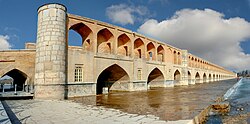 | |
| Coordinates | 32°38′41.53″N 51°40′3.32″E / 32.6448694°N 51.6675889°E / 32.6448694; 51.6675889 |
| Crosses | Zayanderud |
| Locale | Isfahan, Iran |
| Characteristics | |
| Design | Arch bridge, double-deck |
| Material | Stone and brick |
| Total length | 297.76 metres (976.9 ft) |
| Width | 14.75 metres (48.4 ft) |
| Longest span | 5.60 metres (18.4 ft) |
| No. of spans | 33 |
| History | |
| Construction start | 1599 |
| Construction end | 1602 |
| Location | |
The Allahverdi Khan Bridge (Persian: پل اللهوردی خان), popularly known as Si-o-se-pol (Persian: سیوسهپل, lit. ' bridge of thirty-three '), is the largest of the eleven historical bridges on the Zayanderud, the largest river of the Iranian Plateau, in Isfahan, Iran.
The bridge was built in the early 17th century to serve as both a bridge and a dam.
History
Si-o-se-pol was built between 1599 and 1602, under the reign of Abbas the Great, the fifth shah of Safavid Iran. It was constructed under the supervision of Allahverdi Khan Undiladze, the commander-in-chief of the armies, who was of Georgian origin, and was also named after him. The bridge served particularly as a connection between the mansions of the elite, as well as a link to the city's vital Armenian neighborhood of New Julfa.
In years of drought (2000–02 and 2013), the river was dammed upstream to provide water for Yazd province.
-
 Panoramic photography of the bridge
Panoramic photography of the bridge
Structure
The bridge has a total length of 297.76 metres (976.9 ft) and a total width of 14.75 metres (48.4 ft). It is a vaulted arch bridge consisting of two superimposed rows of 33 arches, from whence its popular name of Si-o-se-pol comes, and is made of stone. The longest span is about 5.60 metres (18.4 ft). The interior of Si-o-se-pol was originally decorated with paintings, which were often described by travelers as erotic.
Gallery
-
 A 17th-century drawing of Si-o-se-pol by Jean Chardin.
A 17th-century drawing of Si-o-se-pol by Jean Chardin.
-
Benches and tables next to Si-o-se-pol.
-
A view of the arches under Si-o-se-pol.
-
 Si-o-se-pol in December 2015.
Si-o-se-pol in December 2015.
-
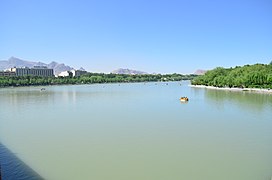 Si-o-se-pol's view of the Zayanderud.
Si-o-se-pol's view of the Zayanderud.
-
 The statue of Allahverdi Khan, next to the bridge.
The statue of Allahverdi Khan, next to the bridge.
-
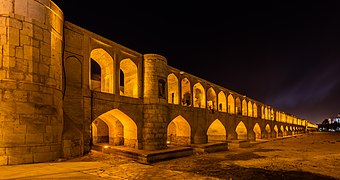 Si-o-se-pol at night.
Si-o-se-pol at night.
-
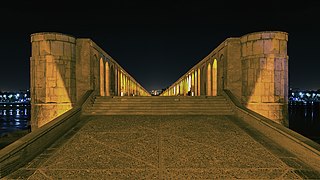 Si-o-se-pol's walkway at night.
Si-o-se-pol's walkway at night.
-
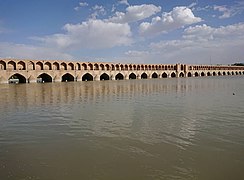 April 2019
April 2019
Transportation
 Chaharbagh Street
Chaharbagh Street Motahari Street
Motahari Street Kamaloddin Esmaeil Street
Kamaloddin Esmaeil Street Chahar Bagh Bala Street
Chahar Bagh Bala Street Mellat Street
Mellat Street Ayenekhaneh Street
Ayenekhaneh Street Enqelab Metro Station
Enqelab Metro Station Si-o-se Pol Metro Station
Si-o-se Pol Metro Station
See also
References
- ^ Babaie, Sussan; Haug, Robert (5 April 2012) . "Isfahan x. Monuments (5) Bridges". In Yarshater, Ehsan (ed.). Encyclopædia Iranica. 1. Vol. XIV. New York City: Bibliotheca Persica Press. Retrieved 25 September 2015.
- Wagret, Paul (1977). Iran. Geneva: Nagel Publishers. p. 226. ISBN 2-8263-0026-1.
- "Drought poses no threat to Isfahan's Si-o-Se-Pol: official". Tehran Times. 25 December 2017.
- ^ "Allahverdi Khan Bridge". Structurae. Retrieved 27 July 2018.
- Savory, Roger (2007). Iran Under the Safavids. Cambridge University Press. p. 170. ISBN 978-0521042512.
- ^ Baker, Patricia L.; Smith, Hilary; Oleynik, Maria (2014). Iran. Bradt Travel Guides. ISBN 978-1-84162-402-0.
Further reading
- Poornaderi, Hossein; Qasemi, Jawad; Zand, Roxane (2008). "Allāhwirdī Khān". In Madelung, Wilferd; Daftary, Farhad (eds.). Encyclopaedia Islamica Online. Brill Online. ISSN 1875-9831.
| Bridges in Iran | ||
|---|---|---|
|  | |
